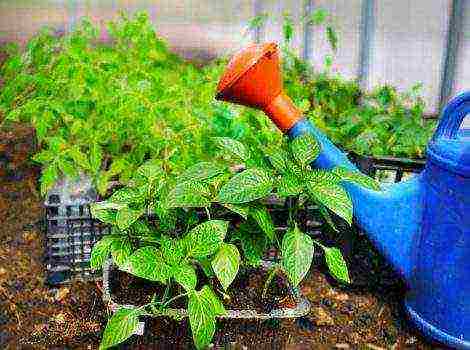Content
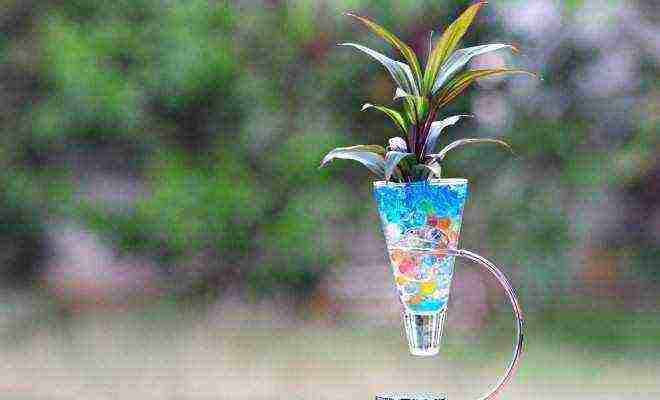
The hydrogel is capable of absorbing and retaining moisture for a long time, which makes it very useful in the flower industry. How can the substance be used?
Hydrogel is a polymeric compound that is actively used in agriculture, and recently florists and phytodesigners have also paid attention to it. Plants can be planted directly in the hydrogel, or you can mix the substance with soil for indoor flowers. The liquid that the hydrogel absorbs does not evaporate or flow onto the tray, and also does not lose nutrients.
Planting plants in a hydrogel
A plant in a hydrogel can become not just an interior decoration, but also an excellent gift, because it looks very original. The hydrogel is commercially available in various colors, so it can be used to create a very bright and beautiful composition. The cost of the substance is not very high, and its consumption is quite small, so one sachet will be enough for a long time.

Hydrogel granules
Tableware. Containers for planting plants should be chosen transparent so that the balls or pieces of hydrogel are clearly visible. As for the shape of the vessels, it can be absolutely any (when planting plants in a hydrogel, the possibility of damaging the roots is minimized). For small plants growing in rosettes, glass goblets can be chosen, and for larger specimens, round or cylindrical vases are suitable.

Glass containers with hydrogel
Hydrogel preparation... You need to fill in the hydrogel with clean water suitable for irrigation (settled, distilled). For 1 g of dry matter, about 300 ml of liquid can go away. It is best to look at the required proportions on the packaging.

Hydrogel
What plants can be grown in a hydrogel? Grow well in polymer absorbent shefflera, chlorophytum, dracaena, tradescantia, syngonium, cordilina, scindapsus... Suitable for shaded corners of the apartment spathiphyllums, ficuses and sansevieria... Some growers grow flowering plants in hydrogel: Kalanchoe, Guzmania, Tilandsia and anthurium.
Do not plant flowers in the hydrogel that do not need frequent watering. For example, most succulents and epiphytes store moisture in leaves and roots, and being in a humid environment will cause them to rot.
Landing. Planting flowers in a hydrogel does not fundamentally differ from planting in ordinary soil. First, the roots of the plants must be rinsed well under running water so that no parts of the old soil remain on them. Next, the container for planting must be filled with a hydrogel, the plant should be placed in it and a little more substance added. That's all, nothing complicated. The only thing to watch out for is to keep the plant upright (this can be a problem as the hydrogel is very slippery).
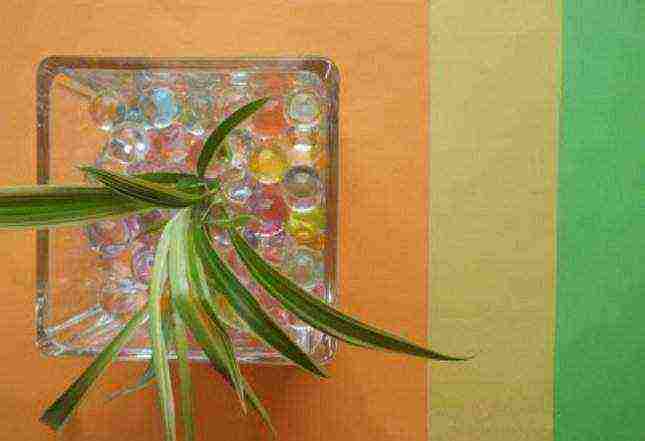
Plant in hydrogel
Features of care. Watering a plant planted in a hydrogel should be 6 times less frequent than plants in soil. The substance itself will tell you about the need for watering, which will begin to settle a little - this means that a lot of moisture has begun to leave it.
Planting plants in soil with hydrogel
Planting indoor flowers in such a soil greatly facilitates their care, because such plants can be watered less often. In addition, the hydrogel helps plants adapt to new conditions more quickly after transplanting.
How to properly formulate a hydrogel substrate?
1. The first step is to mix the substance with a suitable substrate. For 1 liter of soil, only 2-3 g of hydrogel is required.
2. Then the granules should be mixed well with the earth.
3. Now the resulting mixture must be watered abundantly so that it is well saturated and the hydrogel absorbs the required amount of moisture. Now plants can be planted in such land.
The hydrogel in the substrate retains its qualities for 3-5 years, so it is enough to add it to the ground once during planting.
What plants can be grown in a hydrogel? For growing in a hydrogel substrate, moisture-loving plants are suitable, as well as species that are suitable for growing in hydroponics. So, you can plant in soil with polymer chlorophytum, ivy, codiaum, kalanchoe... Some growers even grow succulents like this, for example, fat woman or spurge... And beautifully flowering Saintpaulias, petunias, gloxinias, when planted in a substrate with a hydrogel, even begin to grow more intensively and bloom more abundantly.
Features of care. Caring for plants planted in the ground with the addition of hydrogel granules is practically no different from ordinary care. The only thing to remember is not to water the plants too often.
 Flower lovers must have noticed beautiful bright balls in glasses or vases on the shelves of flower shops. In gardening, this know-how has appeared recently, but the tool immediately became popular with flower growers. Beautiful and bright balls are a hydrogel for plant care. What is this innovation, how to use it correctly and what should be considered when buying a hydrogel for plants?
Flower lovers must have noticed beautiful bright balls in glasses or vases on the shelves of flower shops. In gardening, this know-how has appeared recently, but the tool immediately became popular with flower growers. Beautiful and bright balls are a hydrogel for plant care. What is this innovation, how to use it correctly and what should be considered when buying a hydrogel for plants?
What is the hydrogel for?
Many flower lovers will be interested in learning in more detail what a hydrogel is, how to use it so as not to harm your favorite plants. Recently, the tool is often advertised and in great demand. This is not surprising, because the colorful granules look attractive, and they can be used for different purposes.
The hydrogel is in the form of granules, less often of a powder, in this form it is sold in bags. Beautiful multi-colored balls are made of granular polymer. The appearance of the balls is very attractive and many gardeners buy hydrogel as a decorative tool. A window sill with flowers looks not only green, but also elegant. But this approach is wrong, since the bright balls have a different purpose.
A hydrogel for indoor plants, absorbs moisture well... By sucking in water, the granules increase tenfold. One gram of hydrogel is capable of absorbing up to 200 grams of liquid. The gel balls give the accumulated moisture to the roots of indoor plants.
The flower hydrogel was designed to keep plants hydrated in between infrequent waterings. The swollen granules mix with the soil in which the flowers grow. On average, plants have enough moisture for 2-3 weeks. The roots grow into granules and absorb water. Much depends on the root system of flowers and its development. The granules continue to remain in the soil and after the next watering they are again saturated with moisture.
Due to this property of the hydrogel, plant roots will not rot from excess moisture. If you water indoor flowers with impure water, and with fertilizers, then the granules will be filled with this composition and bring double benefits to the plants. There are two types of hydrogelsintended for flowers.
- Soft - it practically has no color, due to its softness, the roots of plants freely penetrate through it and feed on moisture. It is great for those who cannot water the flowers often, and for germinating seeds and rooting cuttings.
- Dense (aqua soil) - can have different shapes in the form of balls, cubes, pyramids.It belongs to the decorative types of polymer, used for germinating seeds, It is convenient to use it instead of water in vases with bouquets of flowers.
Hydrogel: instructions for use
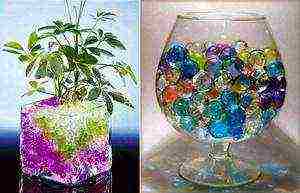 Hydrogel granules come in a variety of colors and sizes, and are sold as such. Package may vary in weight... Typically, small granules are used to germinate seeds, while larger granules are used to add to the soil. The color of the substance does not affect its properties.
Hydrogel granules come in a variety of colors and sizes, and are sold as such. Package may vary in weight... Typically, small granules are used to germinate seeds, while larger granules are used to add to the soil. The color of the substance does not affect its properties.
Before using the gel, it is soaked in water, after which it absorbs moisture and significantly increases in size. It is believed that only 2 tablespoons of granules are enough for a 3-liter volume. After the granules are filled with water, they can be thrown into a colander and the remaining water drained.
Unused pellets can be stored perfectly in the refrigerator in an airtight container. When stored at room temperature, they shrink and crystallize.
In order to germinate seeds, the hydrogel balls must also be saturated with water and preferably with fertilizers. In this state, it will do more good. The pellets themselves do not contain the nutrients necessary for the plants, therefore water-soluble fertilizers will promote good growth and seed germ development.
Very often, gardeners use the substance to germinate seeds in several convenient ways. Much depends on the size of the seeds. Initially, the hydrogel was invented for use in agriculture, but as time has shown, it has become more in demand among flower growers.
The seeds can be sown in pure gel with water. After being saturated with moisture, they swell greatly, after which they can be crushed to the desired state in a convenient way:
- rub through a sieve;
- grind with a blender.
The prepared mass is laid out in a container with a layer of 3 cm and seeds are spread on top. Very large granules can be cut in half and spread the seeds on top by gently pressing with a toothpick. If the seeds are buried too deep, they will not have access to air. The entire seed is covered with foil. It needs to be removed periodically to ventilate the seeds.
Very often, gardeners use hydrogel to grow seedlings, in the ratio 3-4 parts potting mix and 1 part granules... The prepared mixture is filled in containers for growing seedlings and a thin layer of pure crushed hydrogel is placed on top. Seeds are placed in the top layer of the gel, after which they are sprayed with water and covered with a film.
You can germinate seeds in a pure gel, but in the cotyledonous leaf phase, the seedlings must be transplanted into the ground. It is advisable to transplant with a piece of gel so as not to damage the root.
Plant hydrogel application
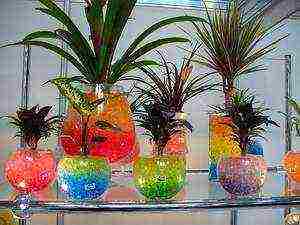 The tool is often used to grow indoor flowers and plants in the garden. It is usually added when planting in a hole or in a potting soil. Due to its ability to retain moisture, the hydrogel is very convenient to use for those who do not have the opportunity to frequently water the plants.
The tool is often used to grow indoor flowers and plants in the garden. It is usually added when planting in a hole or in a potting soil. Due to its ability to retain moisture, the hydrogel is very convenient to use for those who do not have the opportunity to frequently water the plants.
The gel is very convenient to use, it can be apply dry and soaked... The dry matter after watering will immediately absorb excess moisture and then give it to the plants. Experts recommend using a swollen gel for potted plants, and adding it dry in the garden. The proportion will depend on many factors:
- soil condition;
- planting conditions;
- frequency of watering.
For a long time, the hydrogel will absorb moisture and then give it to the plants. After the expiration date, it decomposes into ammonium, water and carbon dioxide, and nothing else is in it.
Hydrogel and aqua primer - what's the difference?
 At the peak of its popularity, many unscrupulous manufacturers of this product began to produce a completely different product. It has nothing to do with the hydrogel. A colorful alternative called "aqua primer" has an attractive appearance and is in high demand.The tool is available in different forms, which performs only a decorative function... If used incorrectly as part of a potting mix, it will only harm the root flower system.
At the peak of its popularity, many unscrupulous manufacturers of this product began to produce a completely different product. It has nothing to do with the hydrogel. A colorful alternative called "aqua primer" has an attractive appearance and is in high demand.The tool is available in different forms, which performs only a decorative function... If used incorrectly as part of a potting mix, it will only harm the root flower system.
The sensational one also often misrepresents information, for example, that aqua soil can be used in its pure form for germinating seeds. Buyers confuse it with a hydrogel and only harm their flowers and seeds. For this reason, a lot of negative reviews about the hydrogel began to appear. Many people simply confuse it with aqua soil, use it incorrectly, so the end result is disastrous.
When buying an aqua primer or hydrogel, you need to consider for which types of plants the products will be used. They are suitable for some plants, but there are types, showing negative reactions... It is best to use both products in a potting mix to keep the flowers in their familiar environment. Hydrogel or aqua soil in its pure form does not have nutrients, therefore it cannot create the necessary conditions for the active development and growth of flowers.
Florists who want to have on their windowsill not just flowers in pots, but real works of interior art, use a hydrogel for plants instead of soil. But many people are not familiar with this decorative and useful material. A hydrogel is a small ball made from a polymer material. They have a high absorption capacity, that is, they absorb water well.
In this case, the granules of the substance increase in size. For high decorative value, they are produced in a wide variety of colors. This material is excellent for replacing soil and has a number of advantages.

Hydrogel benefits
- The granules are absolutely safe, non-toxic. At the same time, the use of hydrogel instead of soil helps to prevent the appearance of midges that breed in the soil. Hydrogel for plants is an absolutely sterile environment in which bacteria, insect larvae and other microorganisms cannot live.When the substance is used together with the soil, after its expiration date, the granules simply decompose into carbon dioxide, water and ammonium. These substances are part of the soil. With this combined use, the balls will last about 5 years.
- Hydrogel granules have a decorative and aesthetic appearance. Placing the granules in a transparent pot, an amazing composition will flaunt on the windowsill. At the same time, the flowers in the hydrogel grow very well.
- For normal soil moisture, a flower hydrogel is a very useful invention. By soaking it with water and mixing it with the soil, you can avoid drying out or waterlogging of the soil. Then the plant will receive moisture as needed. And if you saturate the balls with liquid fertilizers and spread them on the bottom of the pot, then the need for fertilizing will disappear, since the plant will receive fertilizers dosed, for a long period.
- Using this development will significantly save time on watering plants. Watering the hydrogel for indoor plants, mixed with soil, the granules will be saturated with moisture and gradually release it. In this case, the need for daily watering disappears, and you can water the plants once a week or two.
- Saving money on fertilizers. When using liquid fertilizers, most of them drain into the pan, and when using hydrogel granules, all fertilizers are absorbed into them and are evenly consumed.
The advantages of this tool are obvious, so it is worth using this material. Even after it has lost its aesthetic appearance, you should not throw it away. The decomposition time of the granules is five years. Therefore, the pellets can simply be buried in plant pots or garden beds.
Varieties of hydrogel
In addition to color differences, the hydrogel is divided into two types - dense and soft.
- Dense, it is called aqua soil. These are balls or pyramids with different shades, they are used as a decorative material for growing flowers. Such material is mainly used for rooting cuttings, plants grow well in aqua soil, but periodically they need fertilizing with mineral fertilizers.
- Soft. Such a hydrogel has no color, and its main purpose is for growing seedlings, introducing them into the soil and germinating seeds. The structure of this product allows the roots of plants to penetrate and receive nutrition and moisture in this way.
But in order for the hydrogel for indoor plants to serve not only for a long time, but also correctly, it must be used according to the instructions.
Application rules
For granules to be beneficial to plants, you need to use it correctly.
- Soaking the hydrogel. If the balls are multi-colored, then the soaking dishes should be separate for each color. The balls from the bag are poured into a container and filled with water. The ratio of granules to water should be 10 grams to 2 liters. If necessary, dissolve fertilizers in water, it is better that they do not have color.
- After soaking, the balls are left to swell for 12 hours, after which they can be used. Each pellet should then grow to 1.5 centimeters.
- The indoor plant hydrogel is placed in a pot. After the granules have swollen, you can start mixing the colors.
- Next, you need to prepare the plant for planting in the hydrogel. For this, the roots are washed with running water. If it is necessary to root the stalk, then it is simply buried in the balls, and it will start up the roots there.
- As the granules dry, they are watered again. If the balls were used to put bouquets in them, then after drying, they can be put back in the bag and used again.
Aqua soil is not only suitable for growing plants, it can be used for cut bouquets and garden plants. In addition, the hydrogel is perfect for moisture-loving plants.


